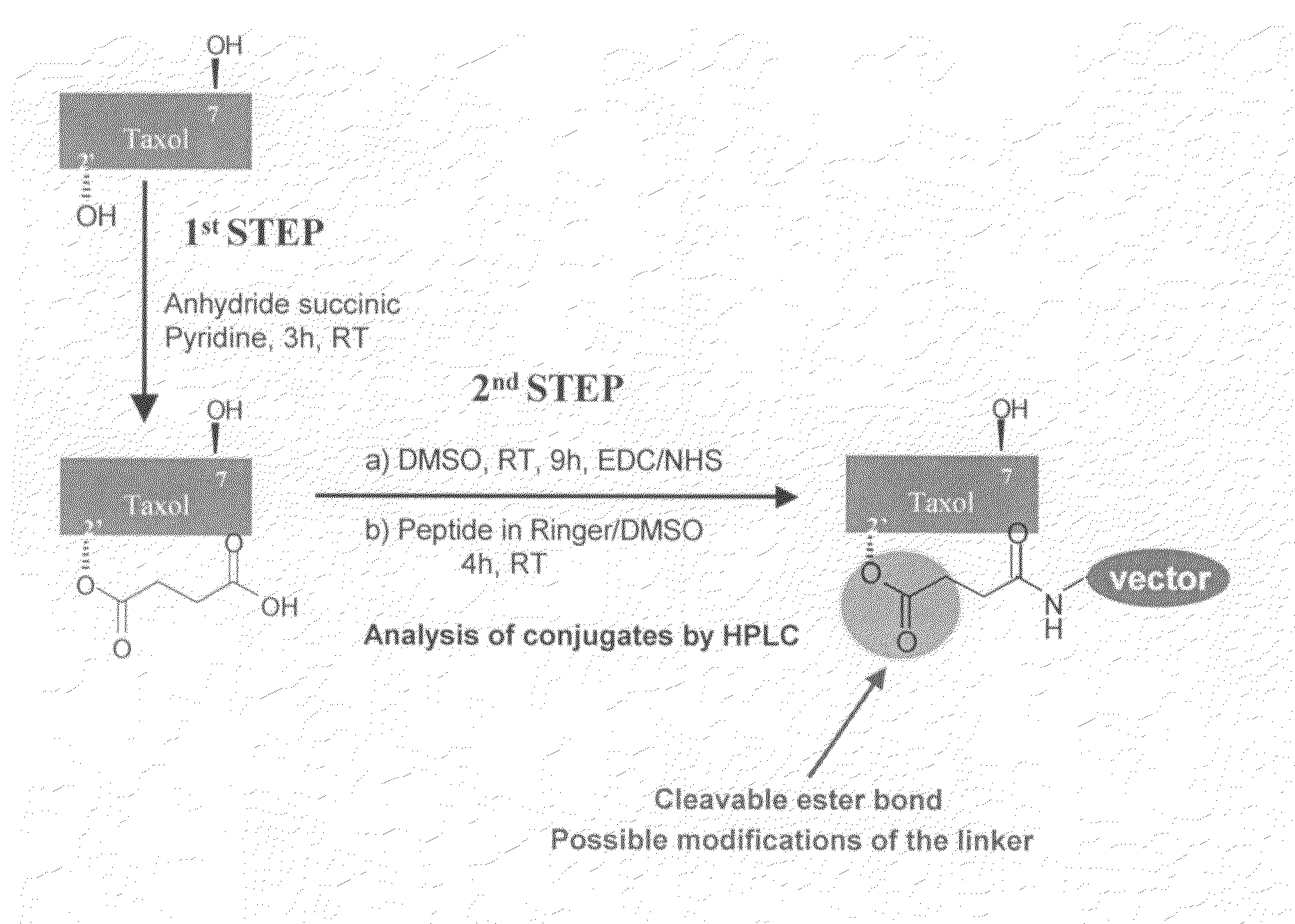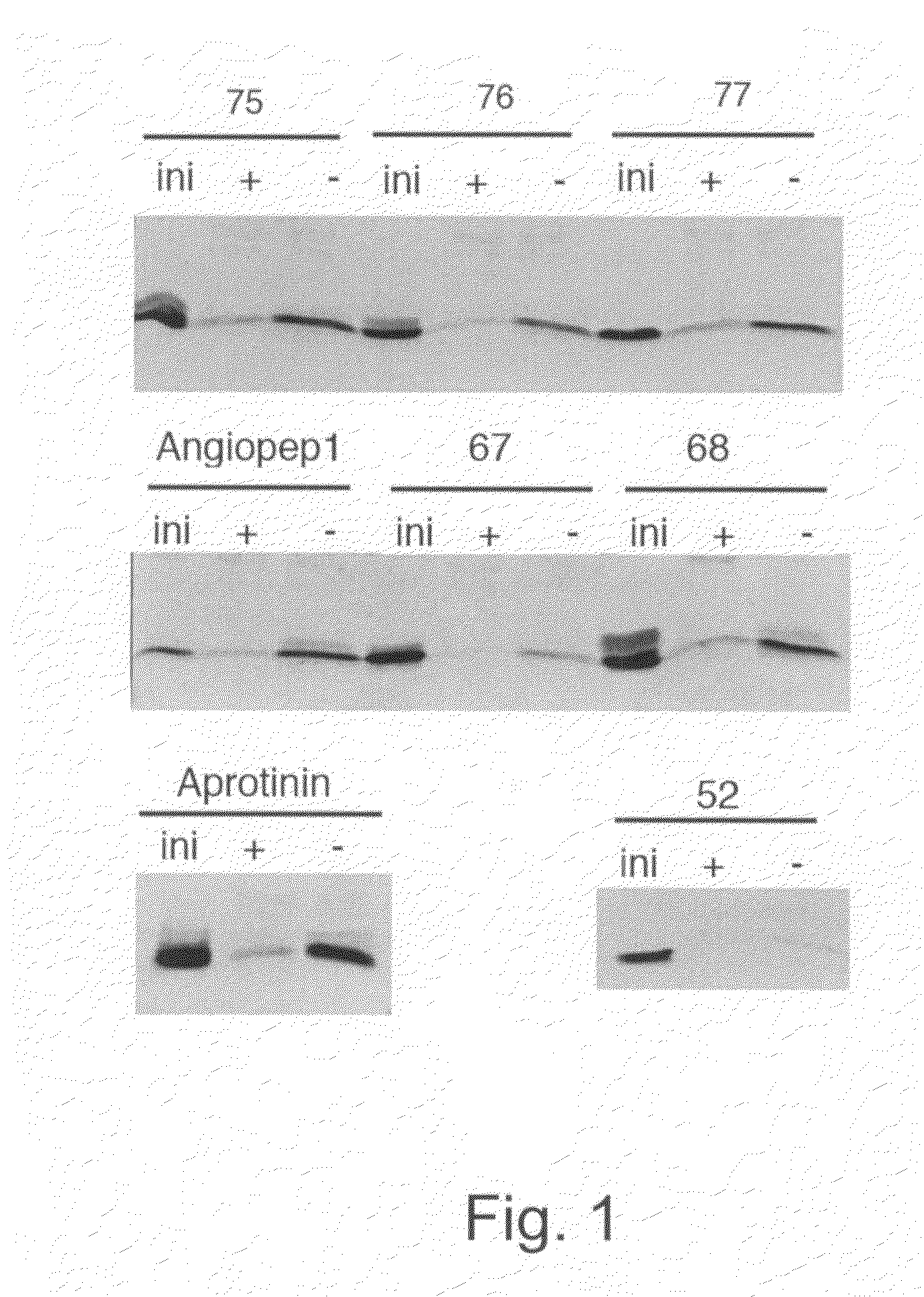Delivery of antibodies to the central nervous system
a central nervous system and antibody technology, applied in the field of drug delivery, can solve the problems of large size of many drugs that show promising results in animal studies for treating cns disorders, no efficient drug delivery approach for the brain, and the blood-brain barrier (bbb) is considered a major obstacle, so as to increase the biological activity of the original polypeptide
- Summary
- Abstract
- Description
- Claims
- Application Information
AI Technical Summary
Benefits of technology
Problems solved by technology
Method used
Image
Examples
example i
Strategies for Drug Conjugation (Paclitaxel)
[0249]For conjugation, paclitaxel (TAXOL™) has 2 strategic positions (position C2′ and C7). FIG. 2 illustrates the method of attachment of the vector or carrier of the present invention to paclitaxel. Briefly, paclitaxel is reacted with anhydride succinic pyridine for 3 hours at room temperature to attach a succinyl group in position 2′. Such 2′-succinyl paclitaxel has a cleavable ester bond in position 2′ which upon cleavage can simply release succinic acid. This cleavable ester bond can be further used for various modifications with linkers, if desired. The resulting 2′-O-succinyl-paclitaxel is then reacted with EDC / NHS in DMSO for 9 hours at room temperature, followed by the addition of the carrier or vector in Ringer / DMSO for an additional reaction time of 4 hours at room temperature. The reaction of conjugation depicted in FIG. 2 is monitored by HPLC. Each intermediate, such as paclitaxel, 2′-O-succinyl-paclitaxel and 2′-O—NHS-succiny...
example ii
Effect of Taxol-Angiopep-2 Conjugate on Mice Survival
[0256]This study with Taxol-Angiopep-2 (herein referred to peptide no. 97 was conducted to determine whether conjugation of Taxol to Angiopep-2 could increase mice survival. The structure of Angiopep-2 is illustrated in SEQ ID NO.:97. For this experiment, mice received an intra-cerebral implantation of 500 000 human U87 glioma cells. After 3 days following implantation, animals were treated with the vehicle (DMSO / Ringer-Hepes 80:20 v / v (i.e., control)) or Taxol-Angiopep-2 conjugate (3:1, i.e., ratio of 3 Taxol molecules for each peptide; TxlAn2 (5 mg / kg)) by tail vein injections (FIG. 8). Mice were monitored every day for clinical symptoms and weight loss. Treatments were administered until animals were sacrificed. As shown in Table 6, we observed that the median survival was 18 days for the control group whereas the median survival for mice receiving the Taxol-Angiopep-2 conjugate was 21 days (FIG. 8). Survival curve obtained for...
example iii
Strategies for Antibody Conjugation
Linkers
[0257]Proteins such as the carriers of the present invention and / or antibody molecules present various groups available for conjugation (coupling; cross-linking). For example, antibodies may be conjugated, without limitation, through sulfhydryl groups, amino groups (amines) and / or carbohydrates. The peptides described herein may be used for generating conjugates. The conjugation methods or cross-linker used is not intended to be limitative.
[0258]Homobifunctional and heterobifunctional cross-linkers (conjugation agents) are available from many commercial sources. Different conjugation agents (homobifunctional and / or heterobifunctional), targeting various available regions were tested for conjugation of antibody molecules to the carriers (vectors) of the present invention. Regions available for cross-linking may be found on heavy and / or light chains of antibodies and / or on the carriers of the present invention. The cross-linker may comprise a ...
PUM
| Property | Measurement | Unit |
|---|---|---|
| Fraction | aaaaa | aaaaa |
| Fraction | aaaaa | aaaaa |
| Fraction | aaaaa | aaaaa |
Abstract
Description
Claims
Application Information
 Login to View More
Login to View More - R&D
- Intellectual Property
- Life Sciences
- Materials
- Tech Scout
- Unparalleled Data Quality
- Higher Quality Content
- 60% Fewer Hallucinations
Browse by: Latest US Patents, China's latest patents, Technical Efficacy Thesaurus, Application Domain, Technology Topic, Popular Technical Reports.
© 2025 PatSnap. All rights reserved.Legal|Privacy policy|Modern Slavery Act Transparency Statement|Sitemap|About US| Contact US: help@patsnap.com



